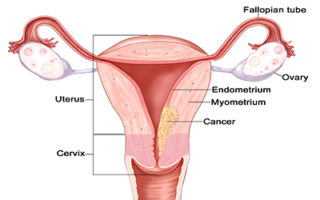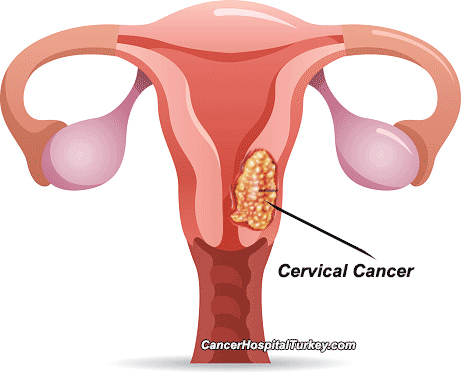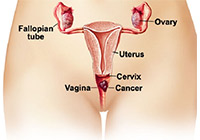Clinical research on gynaecological cancer

Gynaecological cancer refers to the five cancers that start in a woman's reproductive system. These five cancers are womb, ovarian, cervical, vaginal and vulval.

Womb cancer is sometimes called uterine cancer or endometrial cancer. Around 9300 woman are diagnosed with womb cancer in the UK each year. The type of womb cancer depends on the type of cell the cancer started in. The endometrium is the lining of the womb and is the most common type of womb cancer. About 95% of endometrial cancers are adenocarcinomas and they are split into three types; endometrioid adenocarcinomas, uterine serous carcinoma and clear cell carcinoma. Doctors divide endometrial cancer into 2 types. Type 1 cancers are the most common type and are usually endometrioid adenocarcinomas and are generally slow growing and less likely to spread. Type 2 cancers include uterine serous carcinomas and clear cell carcinomas and these are generally faster growing and more likely to spread. Other types of womb cancer includes sarcoma of the womb (uterine sarcoma) that develop in the muscle layer of the womb rather than the lining and uterine carcinosarcoma (combination of both endometrial cancer and sarcoma). Survival depends on many different factors including the individual's condition, type of cancer, treatment and level of fitness. Generally for women with womb cancer in England and Wales around 90% survive their cancer for 1 year or more, around 80% will survive their cancer for 5 years or more and 75% will survive their cancer for 10 years or more after diagnosis. Treatment depends on the type of cancer and the treatment stage. The main treatments are surgery, radiotherapy, chemotherapy and hormone therapy or a combination of these treatments.

The cervix is the lower part of the womb, also called the neck of the womb and is the opening to the vagina from the womb. Around 2,300 women are diagnosed with cervical cancer in the UK each year. There are different types of cervical cancer and the main 2 types are squamous cell cancer and adenocarcinoma. Between 70 to 80% of cervical cancers are squamous cell cancers. These arise from the squamous cells that cover the outer surface of the cervix. Adenocarcinomas arise from glandular cells that are scattered along the inside of the passage that runs from the cervix to the womb. More than 10% of cervix cancers are adenocarcinomas; both are treated in the same way. Other rare types include small cell cancer, lymphomas and sarcomas. Survival depends on different factors include the individual's condition, type of cancer, treatment and level of fitness. Generally, for women diagnosed with cervical cancer in England and Wales more than 80% will survive their cancer for 1 year or more, more than 65% will survive their cancer for 5 years or more and more than 60% will survive their cancer for 10 years or more after diagnosis. Treatment depends on the type of cancer, the grade, stage and general health. Treatment types include surgery, chemoradiotherapy (chemotherapy and radiotherapy together), radiotherapy and chemotherapy.

The vagina is the elastic, muscular passage that leads from the cervix to the vulva. Vaginal cancer is very rare with around 250 women diagnosed in the UK each year. The type of cancer depends on the specific type of cell that the cancer developed from. More than 80% of vaginal cancers are squamous cell cancers. Verrucous carcinoma is a rare type of squamous call vaginal cancer that is slow growing and rarely spreads to other parts of the body. Around 10% of vaginal cancers are adenocarcinomas. There are 4 main types of adenocarcinomas; clear cell adenocarcinoma, papillary adenocarcinoma, mucinous adenocarcinoma and adenosquamous carcinoma. Other rarer types of vaginal cancer include sarcoma, embryonal rhabdomyosarcoma, melanoma and small cell cancer. Survival depends on many different factors including the individual's condition, type of cancer, treatment and fitness level. In England, more than 80% will survive their cancer for 1 year or more, around 65% will survive 5 years or more and around 55% will survive their cancer for 10 years or more after diagnosis. The two main treatments for vaginal cancer are radiotherapy and surgery or a combination of the two.

The term vulva means the external sex organs of a woman and is made up of two pairs of lips. Between the lips is two openings, one opening is the entrance to the vagina and the second opening is the urethra, which is the tube that carries urine from the bladder to the outside of the body. Vulval cancer is a rare cancer with around 1,300 cases diagnosed each year. There are several types of vulval cancer. Squamous cell carcinoma is the most common type with around 90% of vulval cancers being this type. Other types include vulval melanoma, sarcomas, adenocarcinoma, basal cell carcinoma, verrucous carcinoma and Bartholin's gland cancer. Survival depends on how advanced the cancer is when it is diagnosed, individual's condition, type of cancer, treatment and fitness level. For all women with vulval cancer 70% will survive their cancer for 5 years or more after diagnosis. The main treatments used for vulval cancer are surgery, radiotherapy and sometimes chemotherapy.

The ovaries are part of a woman's reproductive system and produce an egg each month in women of childbearing age. Around 7400 women are diagnosed with ovarian cancer in the UK each year. The type of ovarian cancer depends on the type of cell the cancer started in. Epithelial ovarian cancer is the most common type of ovarian cancer and accounts for 90% of all ovarian cancers. Other types of ovarian include teratoma of the ovary, granulosa tumour of the ovary, fallopian tube cancer and borderline ovarian tumours. Survival from ovarian cancer depends on the individual's condition, type of cancer, treatment and fitness level. For women with ovarian cancer in England and Wales, more than 70% will survive their cancer for 1 year or more, almost 50% survive their cancer for 5 years or more and 35% will survive their cancer for 10 years or more after diagnosis. The main treatments for ovarian cancer are surgery and chemotherapy with almost all women needing surgery.
Advanced ovarian cancer is difficult to cure. Most patients are free of the disease after completing initial surgery and chemotherapy but the cancer usually comes back. This is because resistance to chemotherapy develops. Scientists are studying the genetic changes that occur in tumours to understand what causes cancer cells to become resistant to drugs. They are also using new imaging technology so they can monitor how tumours are responding to treatment and whether they have spread to other parts of the body.
Paclitaxel is widely used to treat ovarian cancer but only about half of patients benefit from it due to drug resistance. The mechanisms of resistance are being studied by collecting and analysing tumour samples, both before and after treatment. This information is being used to help develop novel therapeutic approaches to identify whether patients will respond to paclitaxel before they start treatment.
The table below lists the current open trials for gynaecological cancers coordinated by the Cambridge Cancer Trials Centre. If you would like further information about how to take part in any of the clinical trials listed here, please talk to your cancer specialist as patients usually need to be referred by their doctor

















